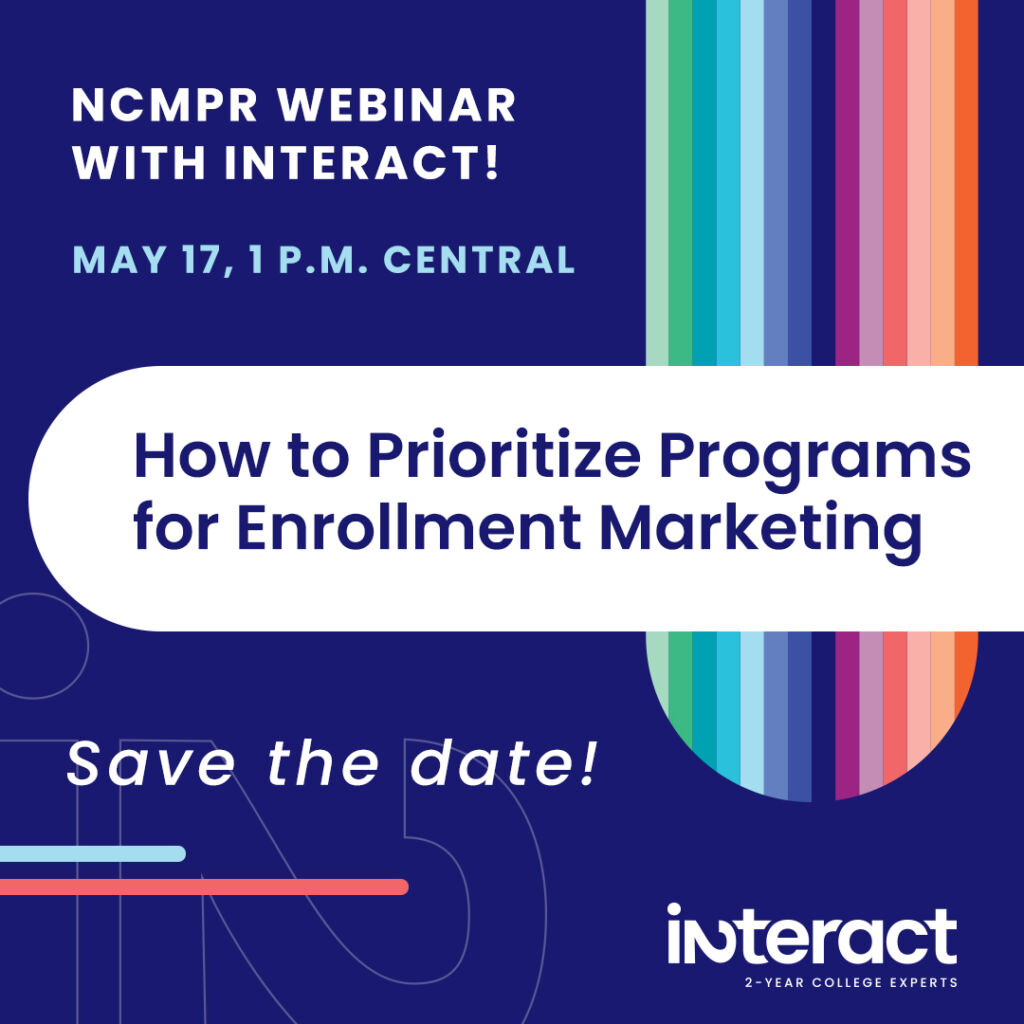Program marketing has changed dramatically over the past few years. For one, there has been a huge increase in demand for short-term certificate training programs. And, of course, there have also been seismic shifts in accessible online education.
The “If you build it, they will come” adage from a Field of Dreams marketing approach won’t work anymore for effective enrollment!

Ready for program marketing tips from our enrollment expert and CEO, Diane Walleser, and our marketing master, Alana Villemez, VP of Business Development?
Keep reading and find out how to prioritize marketing based on the program life cycles and what you can do to align your messaging to your audiences.
1. How the Program Life Cycle Works
Not all programs are created equally, based on enrollment and labor market demand. Since community colleges usually have limited budgets, it makes sense to make those marketing dollars count in producing the best ROI.
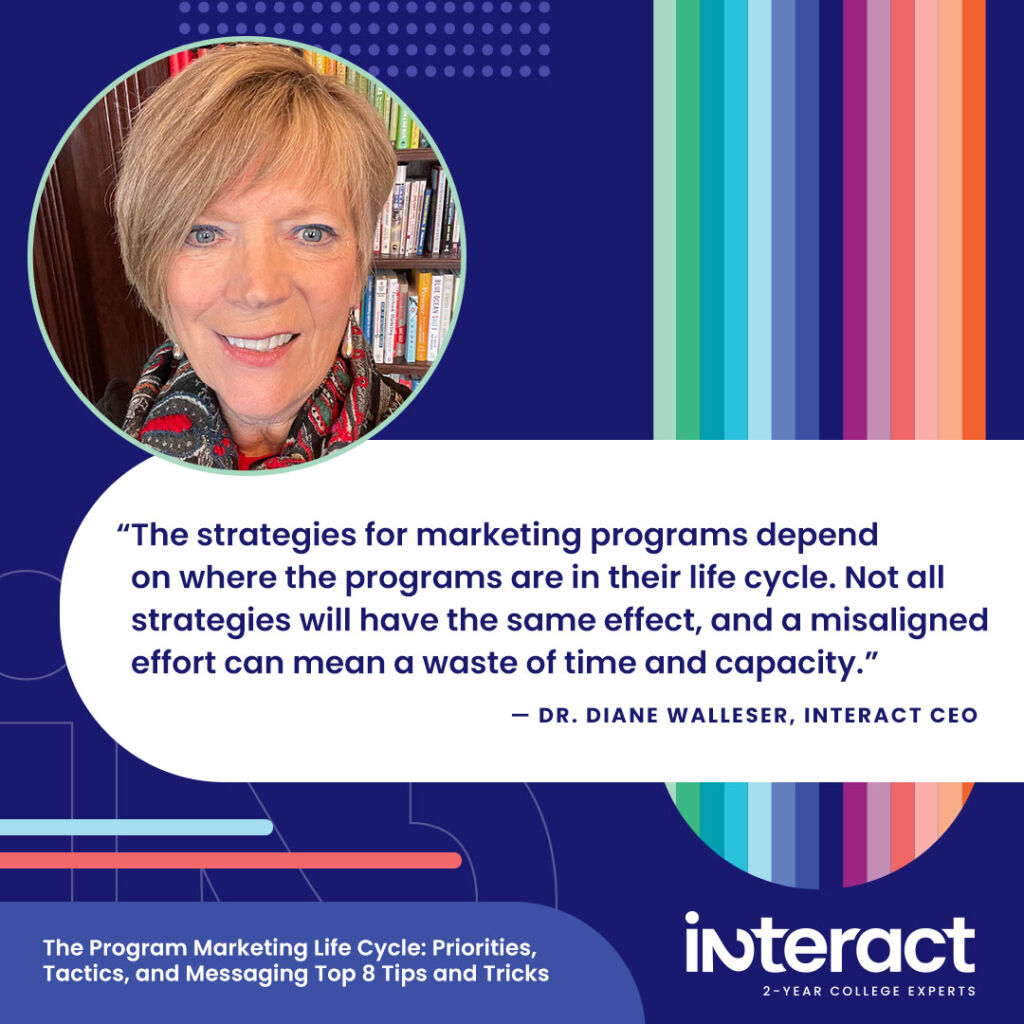
“The strategies for marketing programs depend on where the programs are in their life cycle,” says our CEO, Dr. Diane Walleser. “Not all strategies will have the same effect, and a misaligned effort can mean a waste of time and capacity.”
Before choosing the right marketing strategy, you have to know which part of the life cycle the program is in.
These are the three phases:
Phase 1: Entering the Market
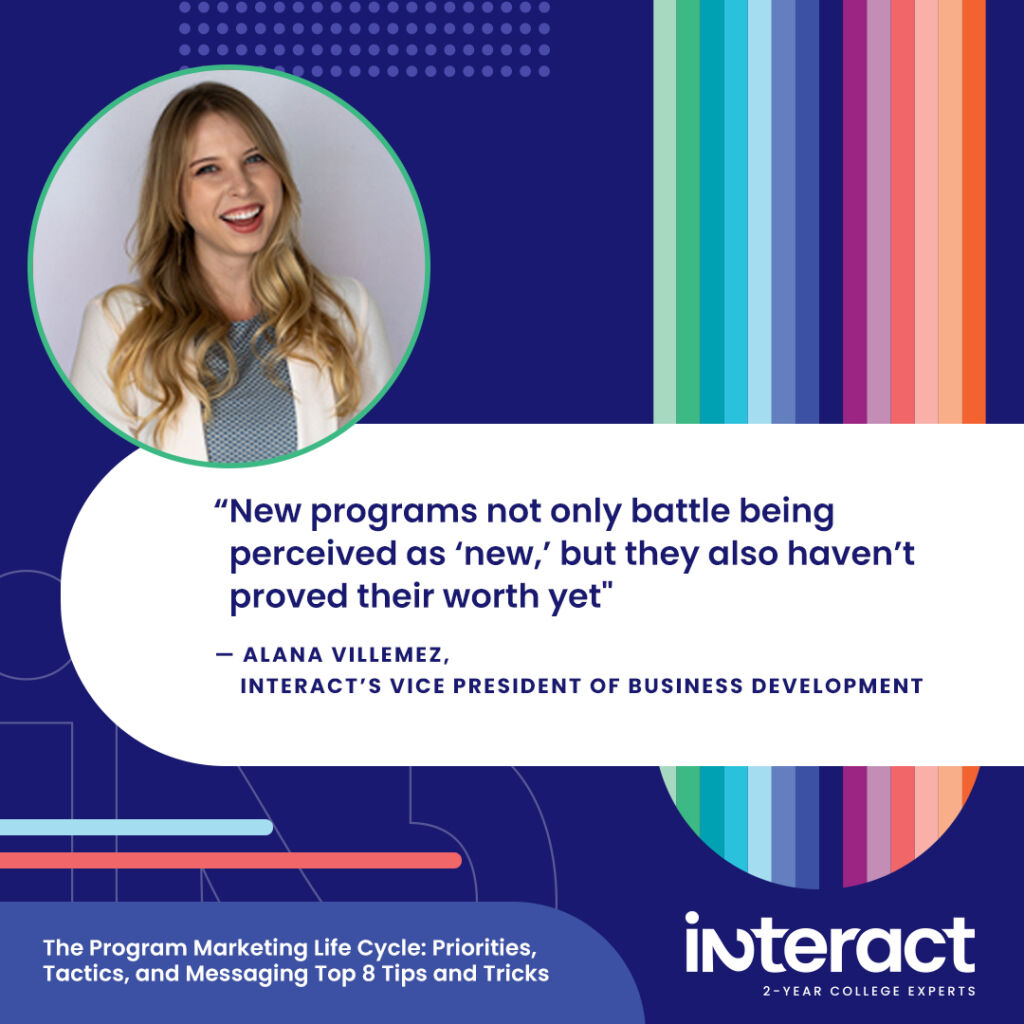
When programs are new and full of promise, they tend to receive the most buzz. But beware! Just like a start-up, new programs cost more to kick-start and market. That’s why it’s a best practice to perform vigorous market research to determine if the proposed program is truly in demand for the region.
Once the need is clear and a program is built, it’s time for marketing. But many colleges forget that building effective campaigns for new programs takes more effort than for established programs. Here’s why:
“New programs not only battle being perceived as ‘new,’ but they also haven’t proved their worth yet,” says Alana Villemez, Interact’s Vice President of Business Development. Consider innovative new programs like entrepreneurship or CAD manufacturing that might seem risky to prospects versus tried-and-true programs like nursing, plumbing, or mechanics.
Breaking Down the Process for Programs Entering the Market
According to Villemez, new programs are fighting stigmas in the following marketing areas:
- Awareness: Your community may not know about this program.
- Outcomes: There aren’t demonstratable, successful outcomes of the program yet.
- Competition: You may have different competitors with more established marketing tracks for the program, especially rival online education courses.
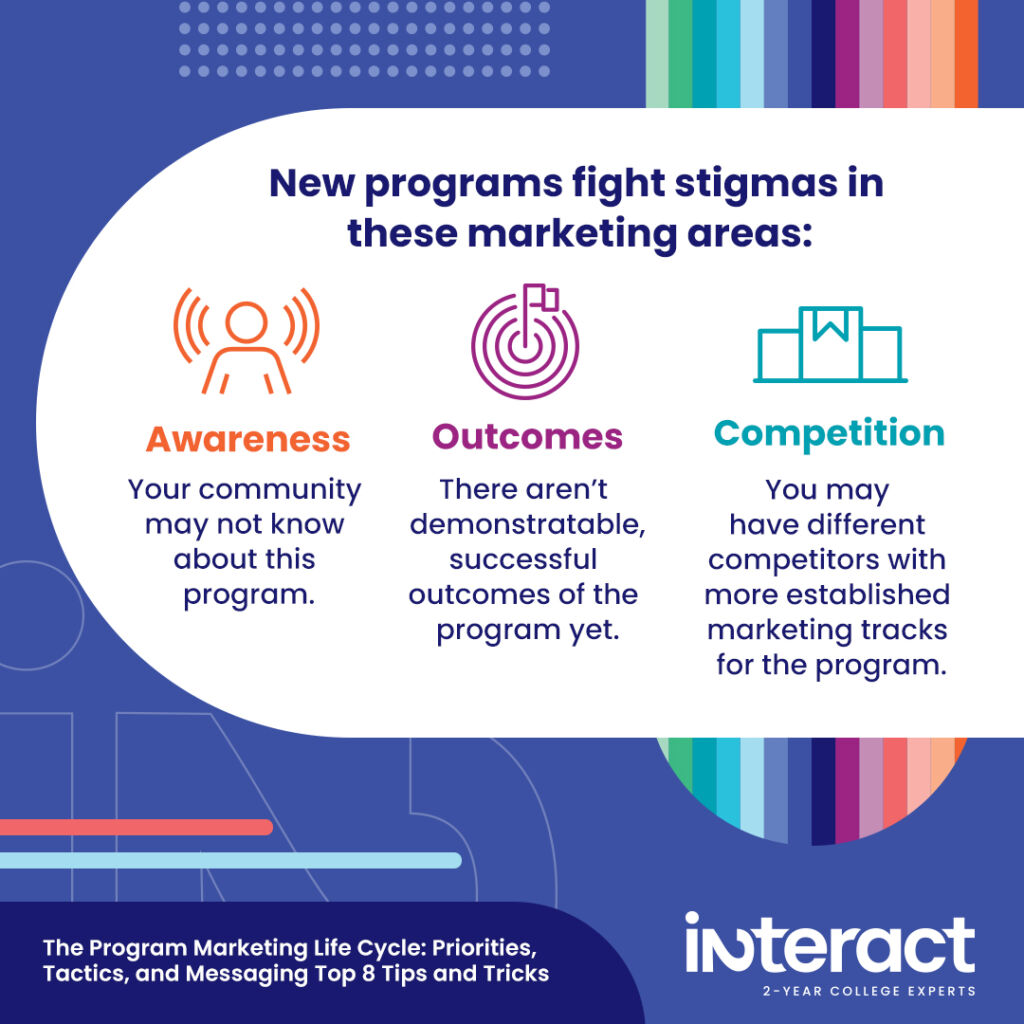
To market these programs and combat stigmas, the following messaging arcs are key:
- Application: What this program is and how it works, including descriptions of the jobs and potential job outcomes
- Motivation: Why enrolling in this new program will benefit the student (For example, you could say there’s demand for this job, the student will be one of the first in this field, and they will be well paid.)
- Differentiation: What does your community college provide that competitors do not? Highlights could include student services, a tight-knit cohort, community integration, and a robust employer pipeline.
“This is not the same message as ‘start here, go anywhere.’” Says Villemez. “These messaging arcs need to resonate on a different level to overcome student hesitations.”
Phase 2: Growing Mature
Program marketing for existing, mature programs has its own unique strategies. Some of these programs might even be among your most popular — your “cash cow” degrees and certificates that bring in the most revenue. Others might be less popular but are still staples of the college experience, such as liberal arts courses or basic requirements.
When it comes to certificate-based programs, in particular, the following programs tend to be the most in demand nationwide:
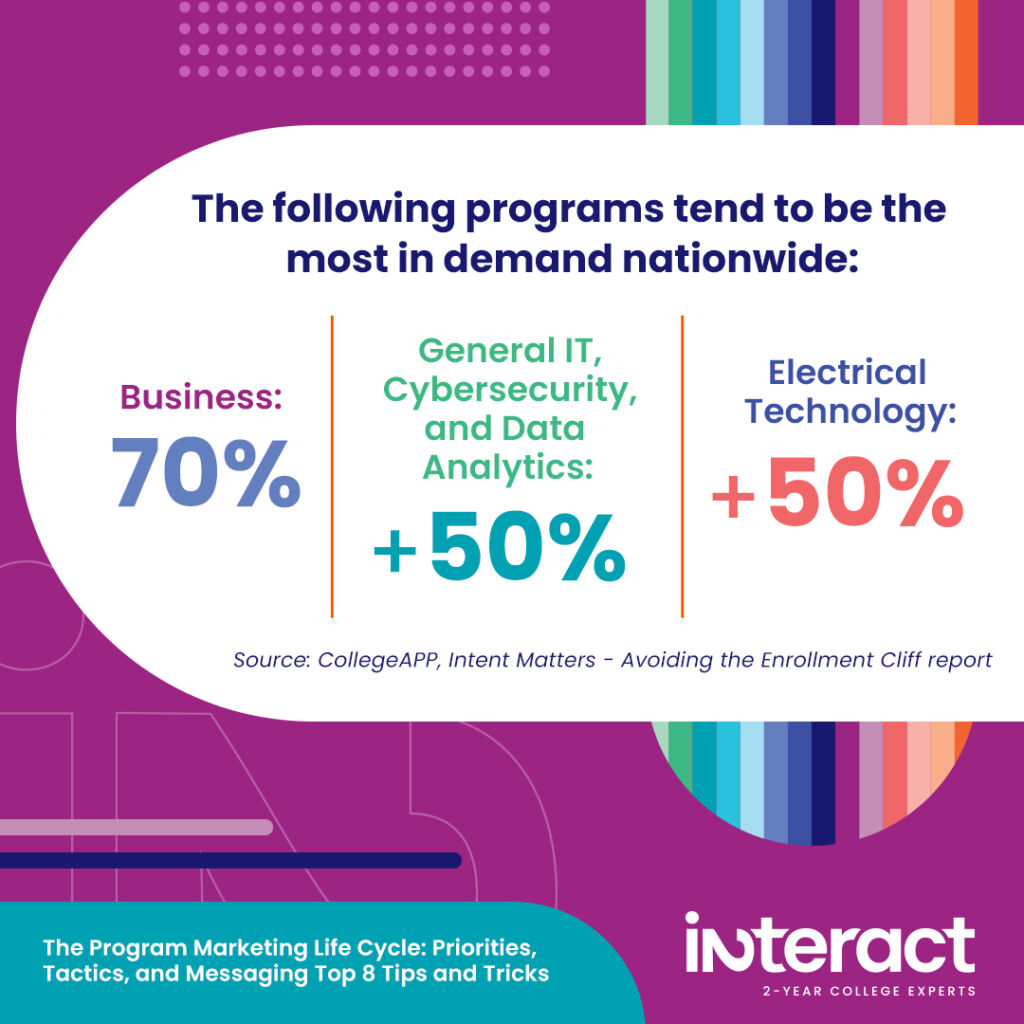
- Business: More than 70% of students are interested in business programs.
- General IT, Cybersecurity, and Data Analytics: +50% of students are interested in these high-tech career options.
- Electrical Technology: +50% of students are interested in sparking a new career on this educational path.
Source: CollegeAPP, Intent Matters – Avoiding the Enrollment Cliff report
“‘Cash cow’ programs are meant to be marketed by faculty,” says Walleser. “Retention and job outcomes are also huge factors in marketing mature programs.”
“Tie these programs to a lifestyle element in your marketing,” adds Villemez. Messaging should be about taking a “path less traveled” with a high reward. To grab prospects’ attention, try leveraging student interests like video games, esports, and computer science. “Utilizing student interests in your outreach is key for engaging traditional students ages 18 to 24,” says Villemez.
Phase 3: Declining Based on Community Need
Typically, these low-enrolled programs are on the way out. There could be multiple reasons for their low enrollment. For one, the labor market demand could be lessening. On the other hand, there could be too many competing schools in the area offering the same programs. For whatever reason, these offerings are on the decline.
Nationwide, the following are the least popular certificate programs. Are they experiencing an enrollment dip at your college?
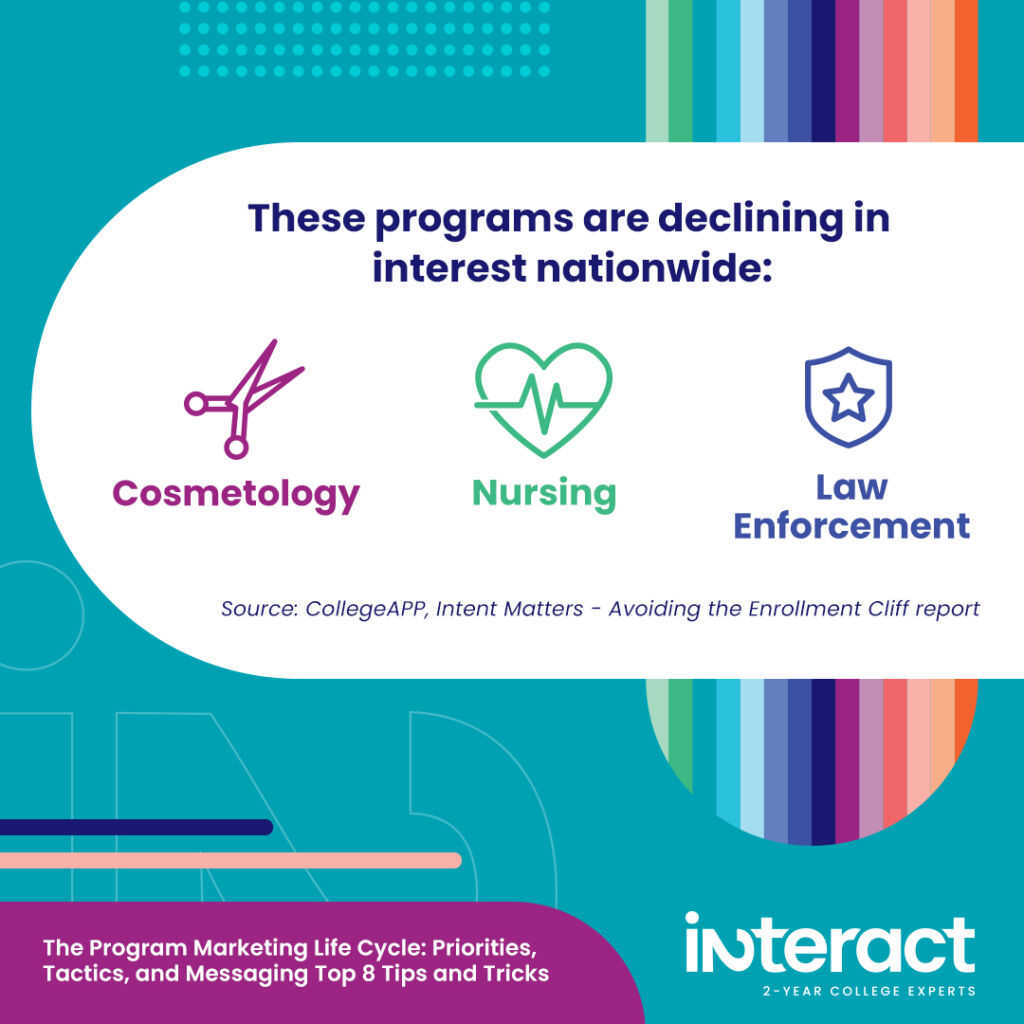
These programs are declining in interest nationwide:
- Cosmetology
- Nursing
- Law Enforcement
Source: CollegeAPP, Intent Matters – Avoiding the Enrollment Cliff report
How should you market these programs? And should you market them at all? Often, these questions can only be answered on an individual basis after a thorough program review and competitor research.
“First, you need to identify factors that may be leading to a decline, many of which could be pandemic-related,” says Villemez. “Then, speak to student fears through your messaging, rebranding the program in light of their fears or hesitations.”
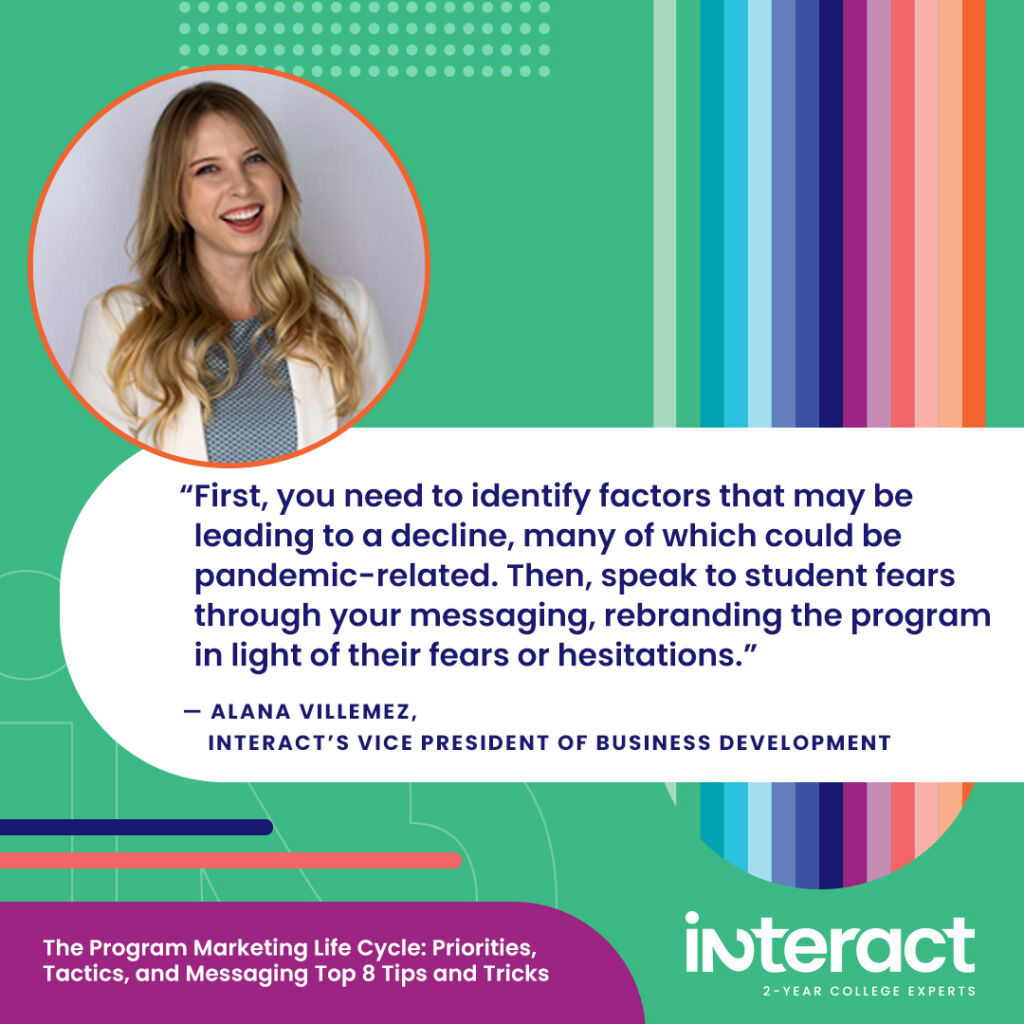
Our VP recommends these two tips for programs experiencing a decline in enrollment:
- Look at the student makeup in these programs and create student personas. Then align your market data to find and target learners who may be interested.
- Create promotional stories about current students and alums to market your programs. Their faces will make people feel like the program is more relatable.
2. Know How Market Forces Effect Enrollment
The most important thing to remember is that market forces always impact enrollment. In some states, demographics drive enrollment more than cost or image. In other states, it could be competition, as we mentioned earlier.
“For better or worse, market forces impact the program life cycle and can determine whether your program will thrive or flounder,” says Walleser.“Understanding these factors and their effects on your programs will help you develop a truly successful marketing strategy.”
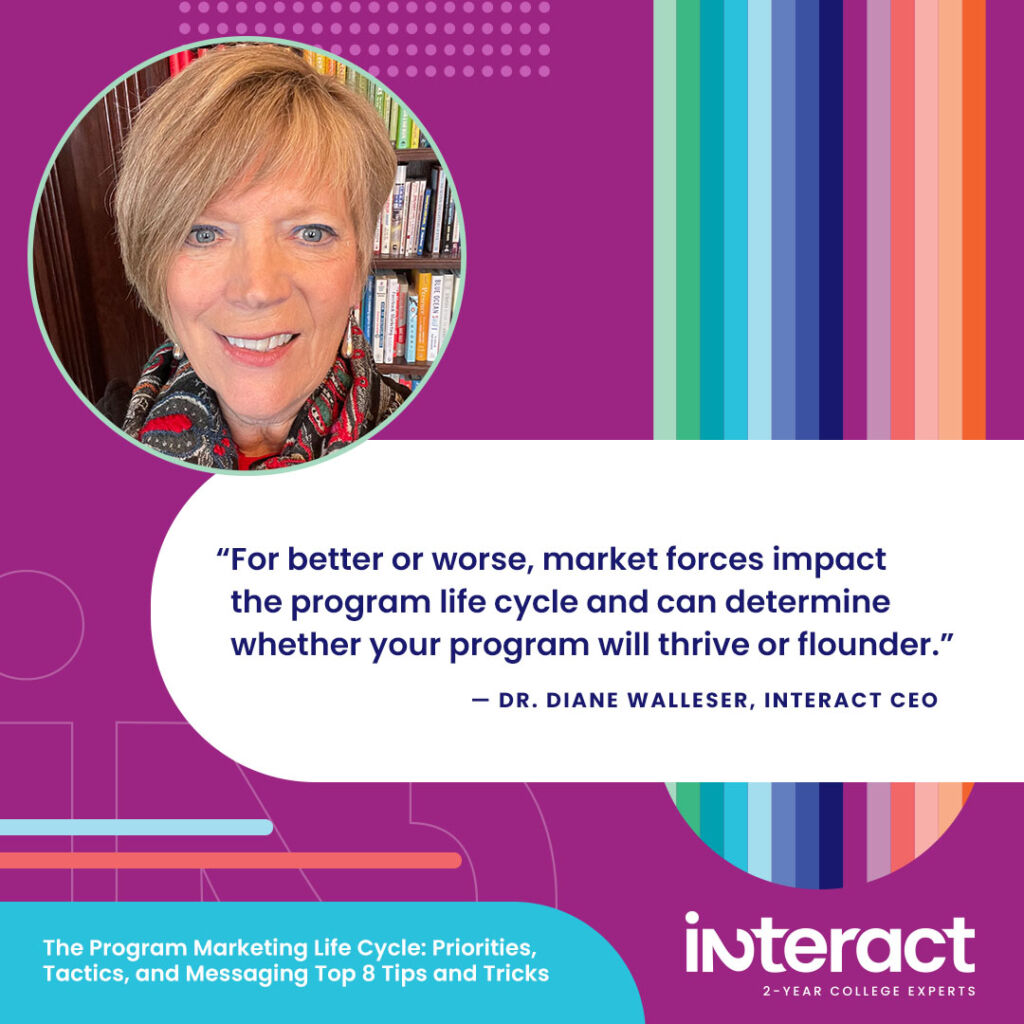
Below are the three top marketing forces to keep in mind that can impact your enrollment and cause programs to decline:
Market Force #1: Local Economy
The businesses and industries that fuel your community’s economy directly impact your enrollment. So do the careers that are growing or disappearing in your region. Many community colleges are on the fast track to supporting economic development opportunities in their region and aligning their programs to them. When a college syncs with industry, it’s a win-win for the workforce and enrollment.
Market Force #2: Feeder Institutions and Programs
The health of your local high schools, adult basic education, ESL, and noncredit programs is crucial to your enrollment pipeline. Dual and concurrent enrollment are also essential for keeping a steady flow of new college students.
Market Force #3: College Completion
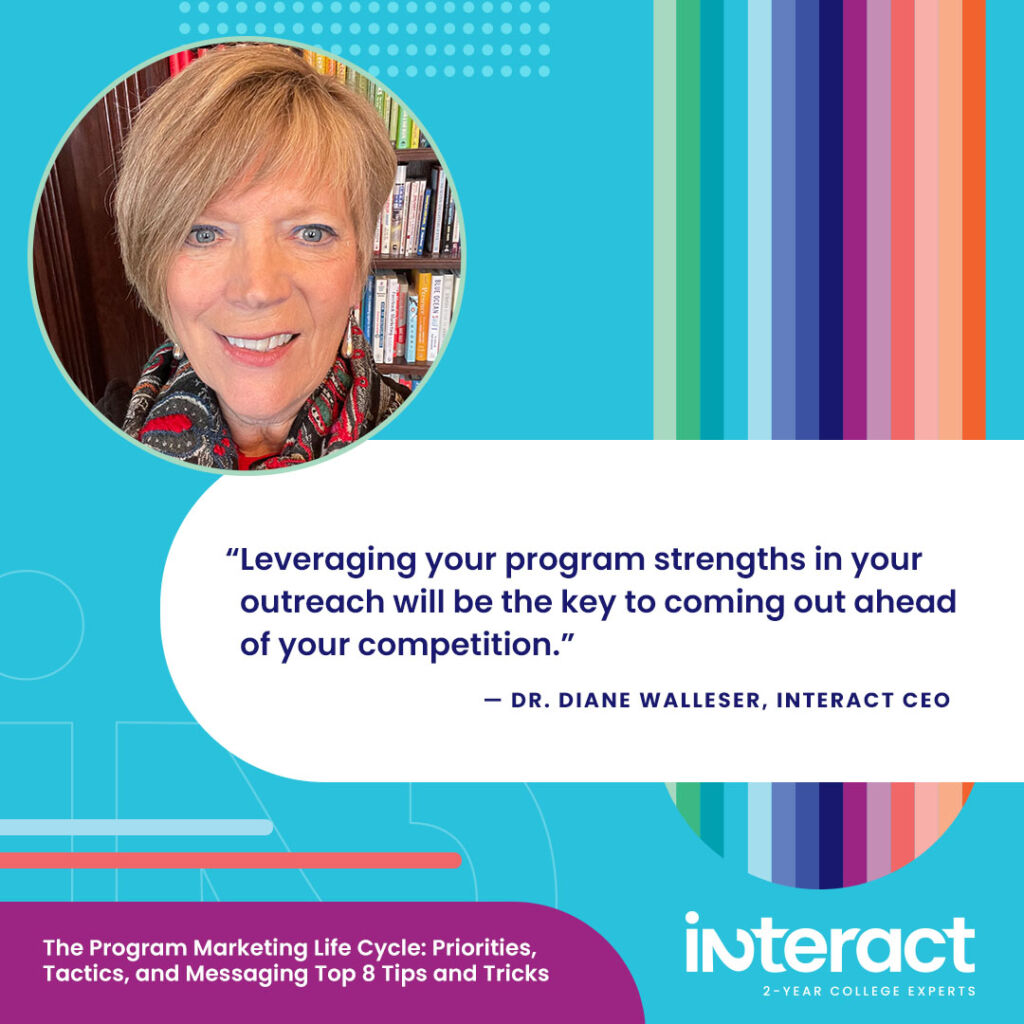
What is the college ecosystem of your community? Nearby community colleges, state universities, private colleges, and online programs can impact your enrollment numbers for better or worse. So, when planning your program marketing, it’s critical to do comprehensive competitor research to carve out your niche. And if you need help with your competitor research, just let us know — it’s one of our specialties!
“The number one thing to keep in mind is that leveraging your program strengths in your outreach will be the key to coming out ahead of your competition,” says Walleser.
3. Determining Your Program Marketing Strategy Based on Where It Is in the Life Cycle
Before you start a fresh campaign, be sure to determine where exactly your program is in its life cycle. That way, you can craft a specific strategy to gain the right attention and the best ROI.
“Start by looking at your programs’ rates of retention, completion, and interest,” advises Walleser. “Then, evaluate the programs with lower enrollment and see if there is truly still a demand and need in your region.”
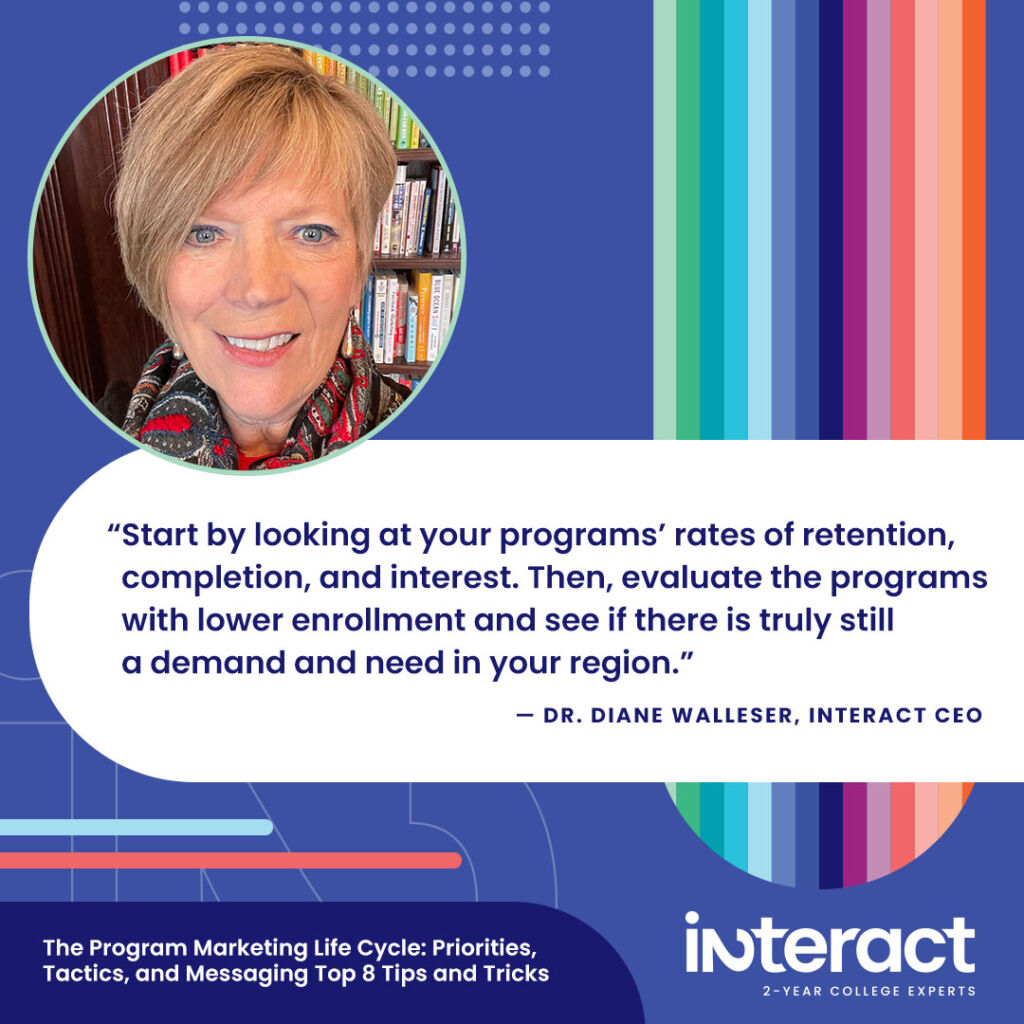
We get it — sometimes it’s hard to know if the program that was once your cash cow is now on its way out the door. It can be hard to let it go, let alone market! On the other hand, you might have a program that’s ready for more time in the limelight, but certain considerations might hold you back from marketing it properly.
If you need a unique solution to help your program marketing, we can help you find answers. Set up a free consultation and discover new solutions!
4. Match Your Messaging to Your Audience
Your program marketing approach depends so much on your different audiences. For example, noncredit students need very different messaging and strategies than traditional students. For one, noncredit students often return to school after a long absence. Their fear of returning to school is also much higher than traditional students.
Plus, there are many sub-audiences within the noncredit population to consider. For example, not all Adult Basic Education (ABE) learners are the same. GED students can differ greatly from ESL students, though their fears and hesitations may be similar.
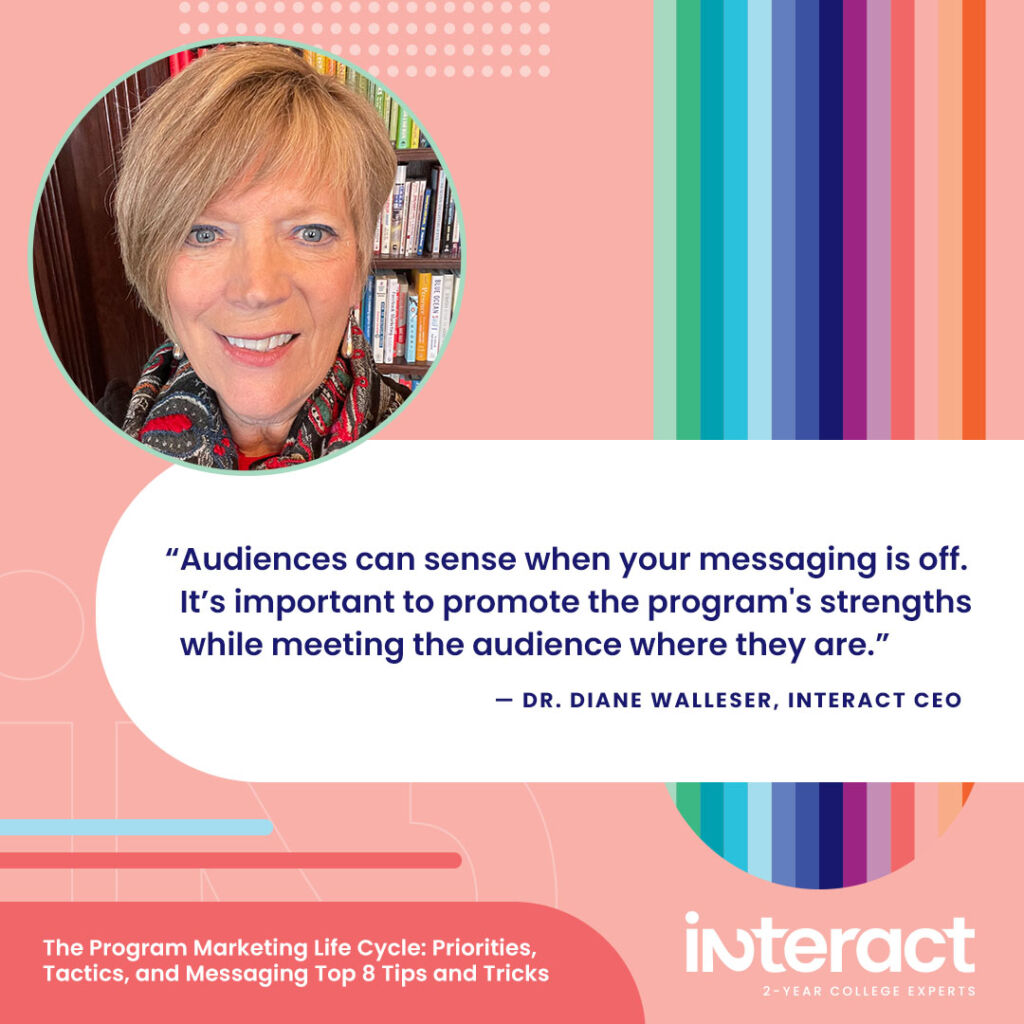
“Audiences can sense when your messaging is off,” says our CEO. “It’s important to promote the program’s strengths while meeting the audience where they are.”
For traditional students, a general rule of thumb is to talk about the lifestyle for different career paths and how education can open the door to opportunities. For adult students, focus more on the low program cost and how quickly they can earn their awards.
5. Eliminate Academic Jargon from Your Program Marketing
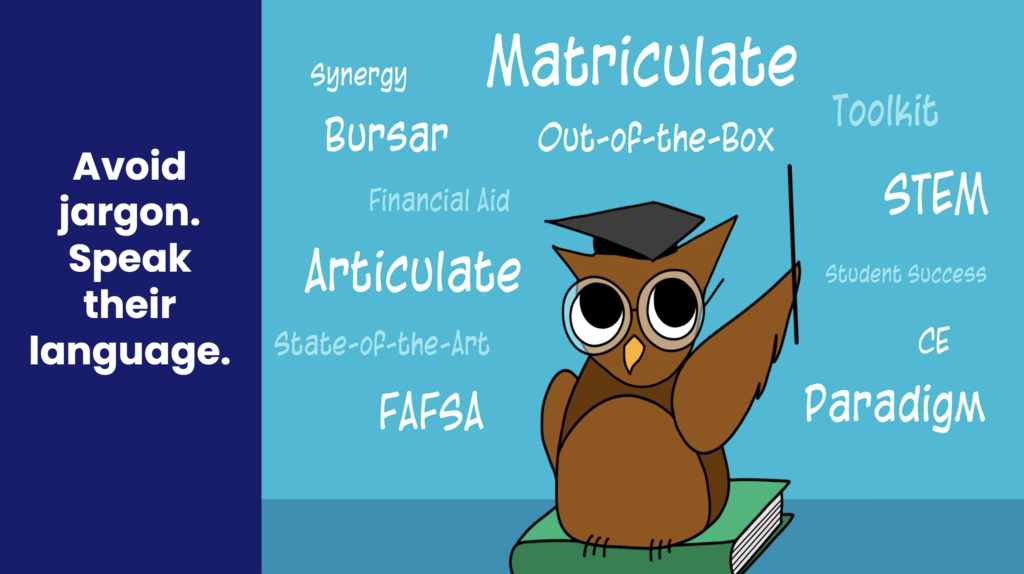
One of students’ biggest messaging complaints is that academic terminology is confusing. You may think your college sounds sophisticated using words like “micro-credentials” and “badging.” But according to the 2022 Online College Students Report by Education Dynamics, learners have no idea what you’re talking about.
Here’s a rule of thumb: When in doubt, take that academic jargon out!
For a deep dive into this topic, check out Academic Jargon: Why It’s Evil and How to Crush It with 7 Simple Tips.
6. Quick List of Best Tactics for Career Awareness Campaigns
Career awareness campaigns are on the rise and in demand. Here is a handy cheat sheet to ensure you maximize your efforts!
Below are the top-performing strategies we’ve found through our research and work with our college partners that consistently produce the best ROI. Of course, your college and region are unique, so always check out your own Media Prefs data or internal research before launching a campaign.
If you’ve hit a marketing wall and are ready to try something new, these strategies might work well for you!
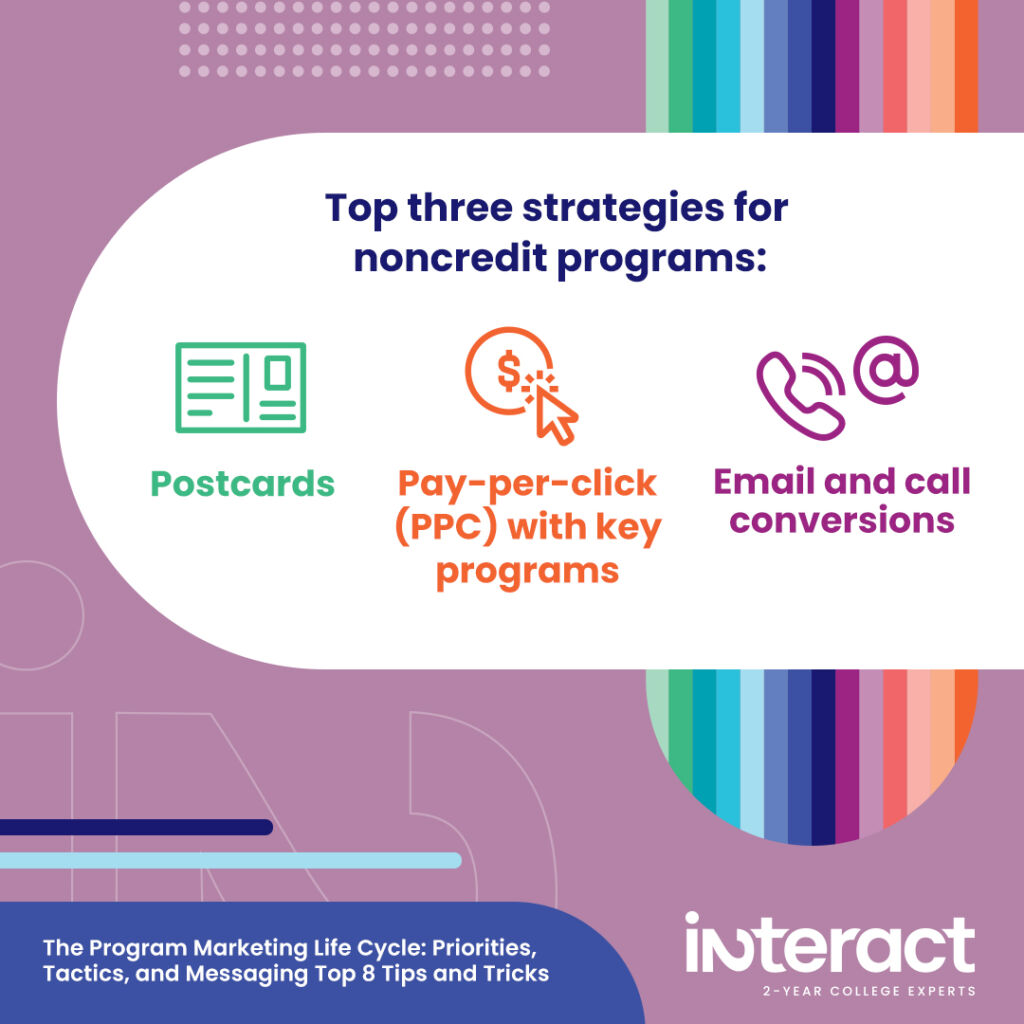
Top Three Strategies for Noncredit Programs:
- Postcards
- Pay-per-click (PPC) with key programs
- Email and call conversions
Top Three Strategies for Careers and Skilled Trades:
- Using program-specific keywords
- TikTok videos
- YouTube videos
“With all of these strategies, be sure to tie your content to your student personas who fit your program,” advises Villemez. “The easiest way to do this is to share authentic student stories, especially through video.”
Our VP says that if you want to expand your strategies, think of ideas, not trends. For instance, is there a way to create some boots-on-the-ground influencer campaigns? Can you ask program directors to come up with their own core concepts?
And ultimately, if you’re not directing prospects to a program or industry landing page, you’re losing out on potential conversions. Says Villemez, “Be sure to have a request-for-information form (RFI) and capture valuable lead contact info early and often!”
7. Always Let Your ROI Be Your Guide

Regardless of your tactics, you’ll always want to track your inquiries. That way, you can see your outreach’s effectiveness and fine-tune your messaging along the way.
How many Facebook inquiries are you getting from your ads? How many inquiry submissions are you receiving from your program landing page?
Schedule a regular time to review your metrics every week. Better yet, have your webmaster set up automatic emails about your analytics and send your ROI straight to your inbox!
Villemez’s key takeaway on program marketing ROI? Leverage your digital tools to take the pulse of your student engagement.
“When I was a student ambassador at my community college, we’d meet with contacts from specific programs of interest for students on our tours to get their feedback,” recalls Villemez. That’s getting the dish on your ROI old-school. She says, “Today, you can get that feedback digitally.”
From your CRM and website analytics to conducting online surveys, tracking student engagement and interest has never been easier. And if you want to ask students about their experience directly? Then Interact’s Media Prefs survey can help show you exactly where your outreach efforts are effective and where they need help.
8. Program Marketing in Action: How to Inspire Returning Students with a Low-Cost, Can-Do Attitude
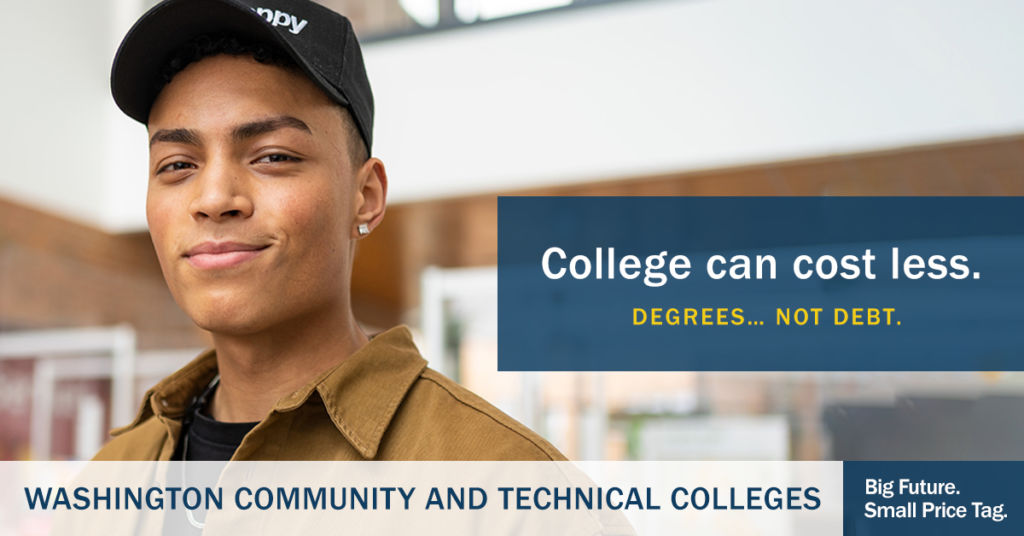
Sometimes, it’s easier to put all the principles of program marketing into action to see how it works. Here’s one of our favorite examples!
The Washington State Board for Community and Technical Colleges needed new messaging. They asked Interact to help target 19- to 45-year-olds who made under a certain income and could benefit most from new grant assistance and financial aid services.
The result was a new anthem: “Big Future, Small Price Tag.”
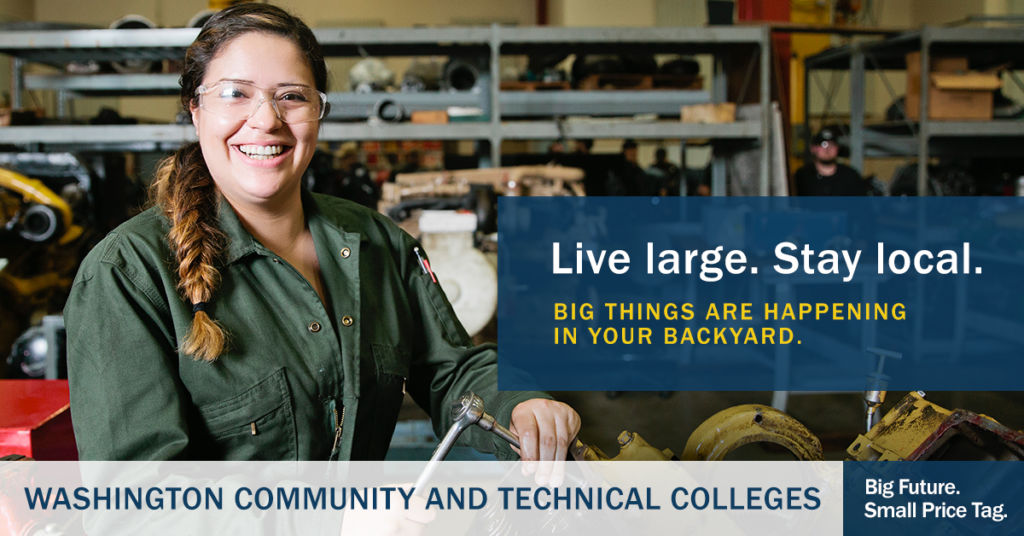
The campaign’s core was a bold, dynamic landing page that showcased program options and college services, inspiring future students to apply.
Though each of the 34 colleges has different offerings and terminology, the team helped organize information across institutions so that students could easily target their interests and quickly connect with programs at their local colleges.
“There’s never been a better time to bring the big picture into focus,” reads the campaign. “Our grads are built for bigger futures, full of higher paychecks and next-level opportunities.”
The Secret to Program Marketing Success
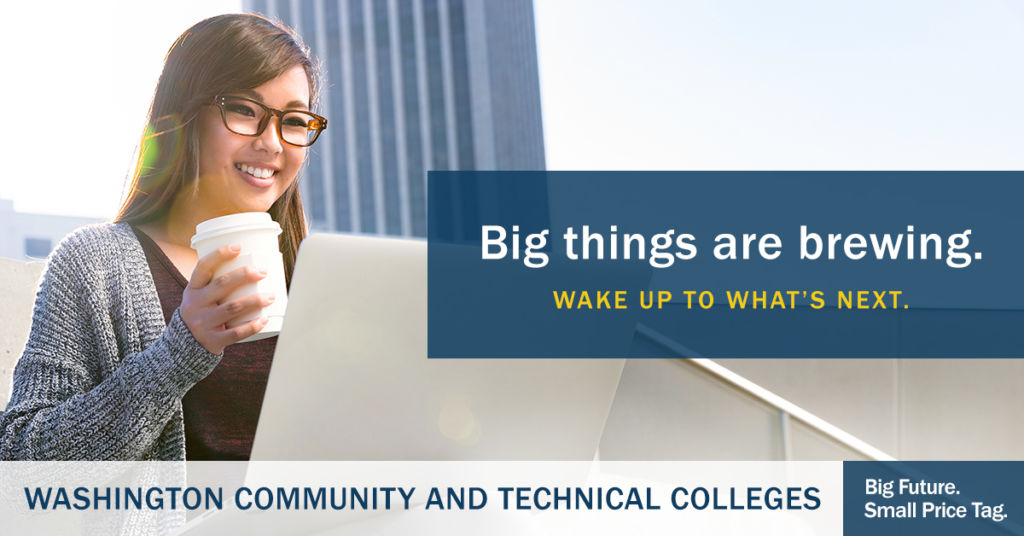
“We mapped every piece of the campaign back to our student personas and our campaign goals,” recalls Villemez. “With this in mind, we directly surveyed the students in career education programs receiving financial aid for initial input and then had them vote on which messaging concept they liked the best.”
The students spoke, surprising all key stakeholders with their choice of “Big Future, Small Price Tag” … and it worked!
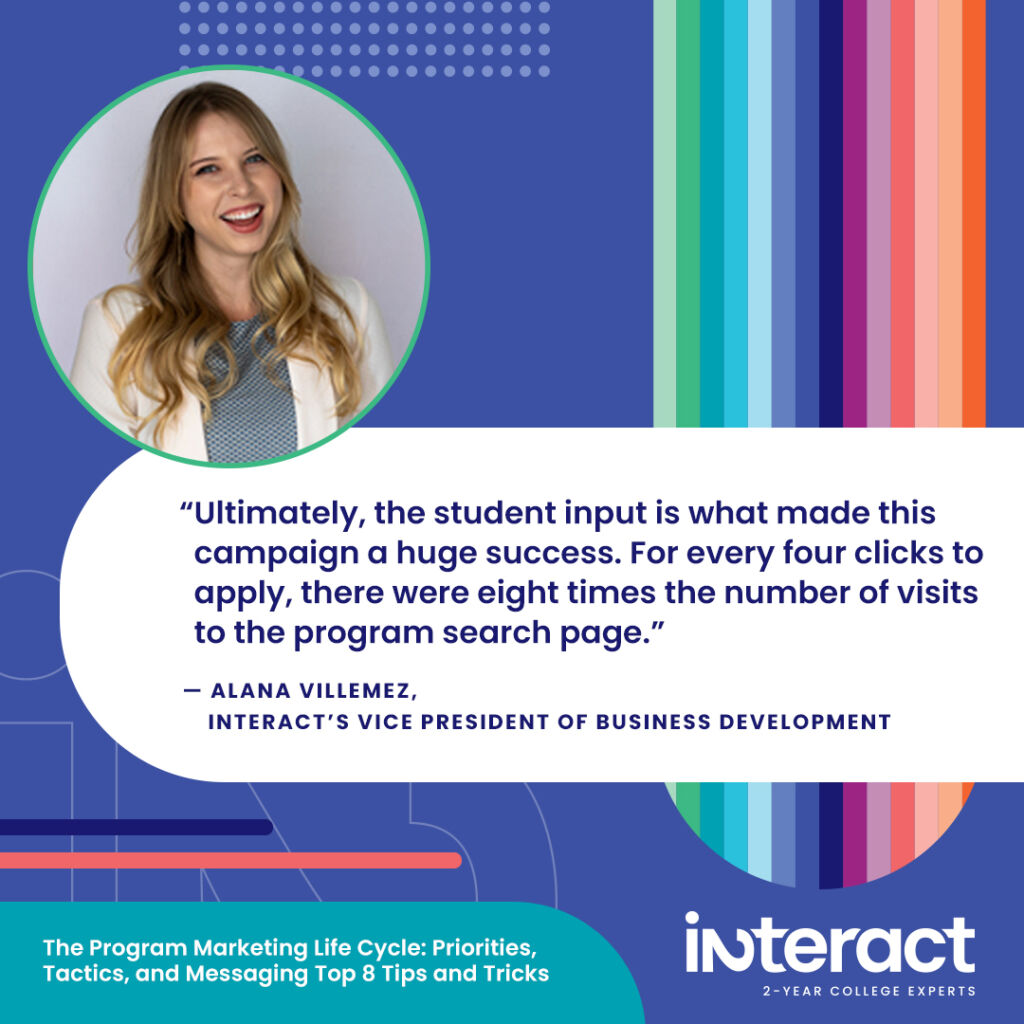
“Ultimately, the student input is what made this campaign a huge success,” says Villemez. The program search page the team created was the most visited on the site. As our VP says, “For every four clicks to apply, there were eight times the number of visits to the program search page.”
Awareness was the name, and inspiring prospects to apply was the game. Interest was almost instantaneous, with +35 million impressions, +32,200 program clicks, and +4,300 apply clicks!
Read more: Group Effort with Gusto: First-Ever Statewide Campaign Builds “Big Futures.”
Are you marketing career education at your college? Then remember: Returning students are looking for a low-cost investment that pays high dividends in a new career path. Craft your messaging accordingly!
Live Webinar on Program Marketing, May 17
Want even more insights into program marketing?
Take a deep dive with Interact and NCMPR in an upcoming live webinar with our CEO, Diane Walleser, and VP of Business Development, Alana Villemez:
Prioritizing Programs for Enrollment Marketing, on May 17 at 1 p.m. Central.
